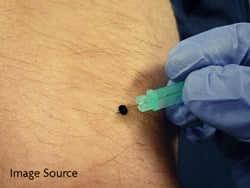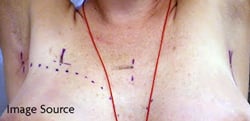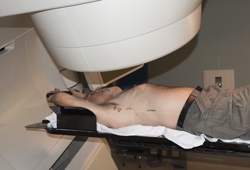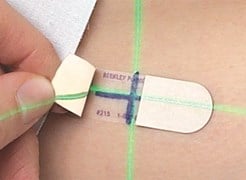
One of the most frequently asked questions of our Radiation Oncology team is what are others doing when it comes to permanent vs temporary marks in treatment set-ups.
The answer is "It depends." Both methods have their pros and cons and in the end it may come down to what will be the most clinically effective and psychologically satisfying for your patient.
Pros and Cons of Permanent Marks:
 Permanent marks are small pinpoint tattoos - meaning permanent ink is injected under the skin.
Permanent marks are small pinpoint tattoos - meaning permanent ink is injected under the skin.
Permanent marks are preferred by many clinicians mainly for the fact that they are permanent. Not only will the marks remain in place and be easily visible (in most cases) throughout the treatment process, they also serve as a permanent record of radiation exposure should additional radiation be required due to recurrence or the development of a new cancer near the original site.
Other advantages to permanent marks are that there is usually no need to re-simulate the patient during treatment to reestablish set-up marks and there are no restrictions as to patient activity.
However, permanent marks in radiation therapy have their drawbacks.
Visibility Issues and Patient Acceptance
As alluded to above, there are times where the tattoo is not easily visible. The marks are very small and sometimes it can take up to 5-7 minutes for the radiation therapist to locate them all prior to each treatment session - longer for freckled, densely haired, or darker-toned skin.
In these instances radiation therapists must either take extra time to find the small bluish-black set-up marks or use other methods to quickly identify them at each treatment. Some of these methods include drawing lines or circles around the mark with a temporary marker - which in itself can have its own drawbacks if proper precautions are not taken to ensure their longevity; investing in black light responsive inks; or using an external cover over the mark, such as Beekley's PointGuards®, to quickly draw attention to it.
 There is also the issue of patient acceptance - some patients object to permanent tattoos. Considerations include cultural or religious beliefs, cosmetic concerns (particularly on face and neck areas), and patient attitudes towards having a permanent reminder of their cancer experience.
There is also the issue of patient acceptance - some patients object to permanent tattoos. Considerations include cultural or religious beliefs, cosmetic concerns (particularly on face and neck areas), and patient attitudes towards having a permanent reminder of their cancer experience.
The value of knowing the exact site of treatment is lost to clinicians when patients opt to have their tattoos removed or, as is trending among breast cancer patients, turned into decorative tattoos along with their surgical scars.
Age and weight gain/loss also compromise the accuracy of the tattooed record of the treatment site over time as the marks are motile with changes in skin elasticity and no longer consistent with internal structures. And, of course, "stick" injuries to both patient and staff always need to be considered when needles are involved.
Pros and Cons of Temporary Marks:
Temporary marks are small pinpoint or linear marks made with a semi-permanent marker. The main upside to temporary marks is that they are temporary and act as a counterbalance to many of the downsides that permanent marks represent.
These marks disappear over time. The patient will not have a visible mark on a sensitive area for the remainder of their life that could make them self-conscious, nor a permanent reminder of what was an unpleasant experience for them.
 The downside to temporary marks is that they are temporary.
The downside to temporary marks is that they are temporary.
Radiation treatment can span 4-6 weeks and if the marks fade or wash off, the patient will need to be re-simulated. Patients may be instructed to limit activities that may cause the marks to wear off.
Making Temporary Marks Less Temporary
More commonly, the marks are covered with a thin, transparent, membrane-like, waterproof polyurethane medical dressing that adheres to the skin. While the dressing allows patients to do more of their regular activities, it does brings its own set of complications into the mix.
Intended primarily for wound and catheter site protection, the dressing often needs to be cut down into small patches and is difficult and time consuming to handle.
As a nursing dressing these are designed to stay on the skin from 24-48 hours but have been known to stay on for a day to a week and will need to be re-covered several times throughout the course of treatment. More concerning, however, is that many patients complain of aggravated irritation from the dressing to their already compromised skin from the radiation treatment.
To address this challenge for radiation therapists, Beekley Medical introduced PointGuards® temporary mark covers.
These pre-cut, clear adhesive covers were made specifically with long-term set-up mark protection in mind. PointGuards are easy to apply, provide a watertight seal and stay in place for up to 4 weeks and are proven to be less irritating to skin than other methods.
So as you can see, the choice between permanent and temporary marks for radiation therapy can be difficult and rely on a variety of factors, but in the end it comes down to what's going to be best for your patient's well-being, both clinically and emotionally.
Related articles:

Mary Lang Pelton
Director of Marketing Communications
